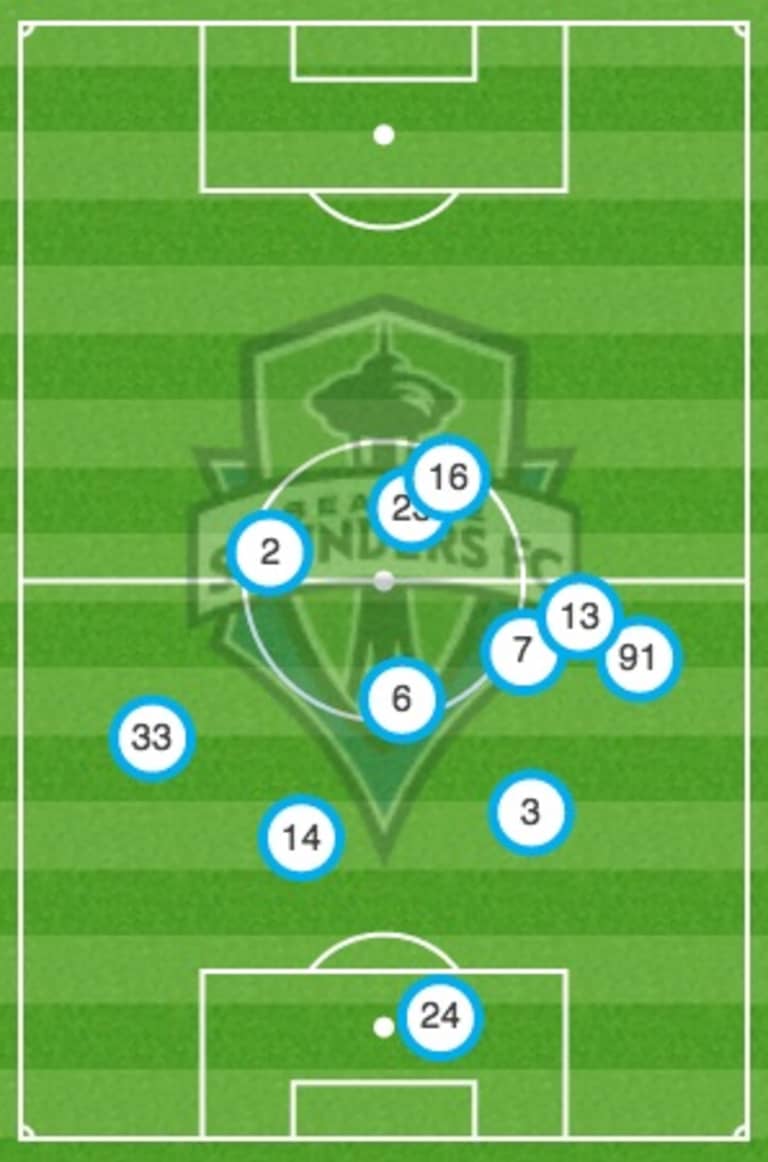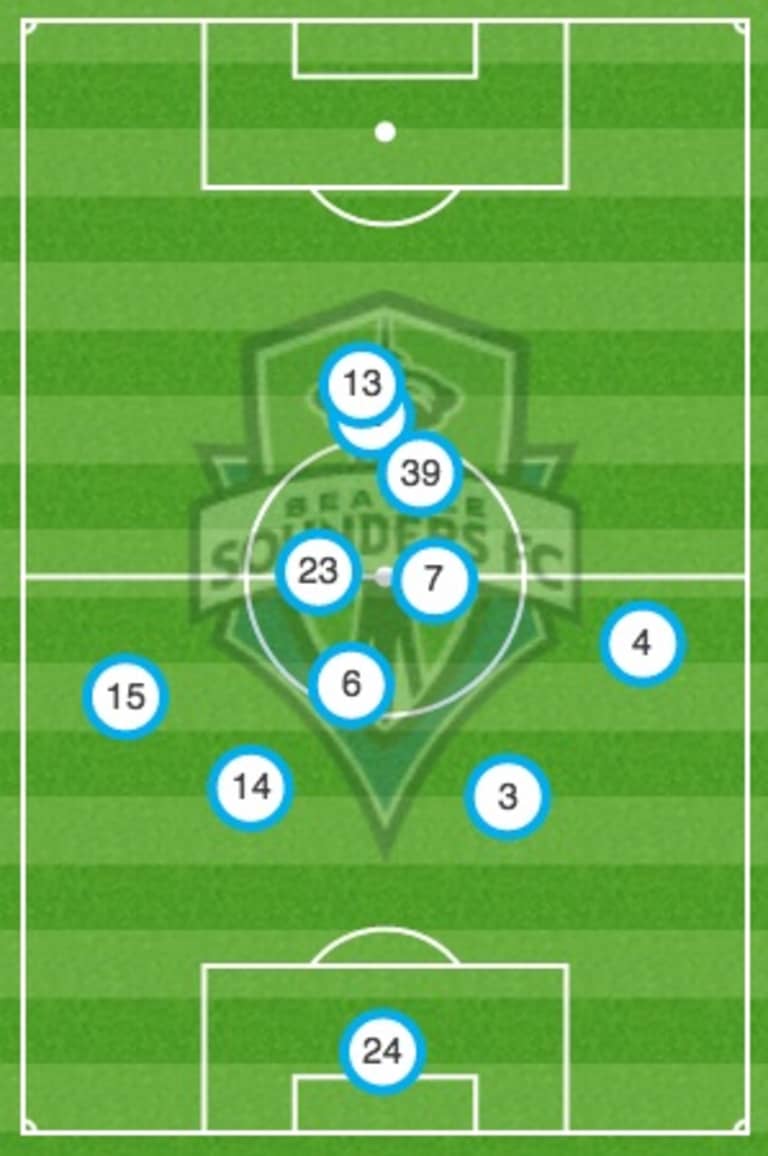The most explosive moment of Jordan Morris’s tremendously young professional career came on the business end of a trademark flash of magic from Andreas Ivanschitz.
In the fracas surrounding Morris’s first career goal as a pro to seal Seattle’s 2-1 win over the Philadelphia Union on Saturday, it was almost easy to forget how Ivanschitz had served CenturyLink Field the moment on a gilded platter.
It was the goal Seattle had been waiting for from its native son, after all, and goals steal spotlights. It is the way of the world.
But beneath the exterior and embedded in the machinery was Ivanschitz, where he’s been stationed throughout an explosively productive first full season in Seattle.
There is nothing particularly flashy about Ivanschitz’s game. Even his pre-match attire appropriately reflects his workmanlike approach to the game. In a tiled pre-match slideshow on the Sounders’ official Twitter account before the Union game showing players arriving before the match, Ivanschitz sheepishly mugged for the camera in a simple gray polo and jeans.
But some three hours later, he was putting the finishing touches on a perfect, simple polo-and-jeans long ball that would launch Morris into the stratosphere.
Ivanschitz’s journey from wide player in 2015 to roving deep playmaker this season is as organic as it is impressive. After arriving in Seattle last August, Ivanschitz was immediately thrust into a role as a left midfielder in head coach Sigi Schmid’s 4-4-2 for the balance of the season. Ivanschitz was good in 2015. He managed a goal and an assist in 439 minutes in a league that notoriously requires a full offseason to adjust.
The coaching staff spent the offseason pondering ways to involve Ivanschitz more intimately in the attack. Could he possibly be the central attacking creator the team has been looking for to link lines that had occasionally been disjointed?
The answer so far in 2016 is that yes, Ivanschitz is capable of doing much more than just providing width. Even if he’s not the singular central attacking playmaker the team had been looking for.
In truth, Ivanschitz’s short 2016 season so far is impressive, but complicated. During the preseason and into the first few games of the year - including the Scotiabank CONCACAF Champions League matches against Club America - Ivanschitz occupied an explicit “rover” role atop the midfield. Schmid’s fledgling 4-3-3 required Ivanschitz to provide the spike atop a midfield trio that now includes Osvaldo Alonso and Cristian Roldan.
In the opening match of the season against Sporting KC, Ivanschitz dutifully filled his new role. In fact, he might’ve done it too well. Ivanschitz pushed so far upfield centrally that he essentially acted as a second striker behind Nelson Valdez.
The problem? Everything to his back. Ivanschitz was so high that a canyon opened up between the forward line and the rest of the midfield.
While Clint Dempsey became disconnected on the left against Sporting KC and Morris spent much of the match too far withdrawn to do much damage, Ivanschitz (No. 23 in the following graphics) did his best to stoke an attack that was moving in at least four different directions.

Ivanschitz’s role essentially began its evolution here. For much of the next month, Ivanschitz continued to be deployed centrally as the Sounders struggled to produce goals from open play. He continued his immense left-footed danger from free kicks, including the corner kick that led to Dempsey’s game-winner against Montreal on April 2. And in flashes, he was the most competent if under-the-radar attacker on the field.
But even as Ivanschitz continued his efficient if slowly progressing adaptation to his new role, the attack struggled to maintain much consistency in front of goal. Which led to one of the subtler but prescient chess piece moves of Schmid’s career.
Against Houston a week later, Schmid essentially swapped roles between Dempsey and Ivanschitz. Dempsey had never taken to his deployment on the left in the 4-3-3, and for all his creativity, Ivanschitz was struggling to carry the linking load in the middle. The Houston game wasn’t particularly pretty, and Seattle barely escaped with a point after a stoppage time equalizer from Chad Marshall. But it set a precedent that carried through Seattle’s tone-setting 2-1 win over Philly a week later.
Now, Dempsey pushed straight up the gut to join Morris, who was deployed as a center forward for the first time. Meanwhile, the left-footed Ivanschitz used his newfound space on the left to collapse the wing and provide airlifted service from the center-left.
If it wasn’t obvious in Houston that Ivanschitz’s new deployment had taken the heat off his back from the opposing central defensive midfielders, then it was blindingly obvious against the Union. This is where Ivanschitz really arrived in 2016.
Remember that average position map from the Sporting KC match on the first day of the year? Here’s what it looked like against the Union on Saturday.

Note the differences. Dempsey is far higher and more connected to the formation, better utilizing the goal-scoring instinct that is his strength at this point in his career. Morris is finally hooked in to Dempsey’s creativity centrally, much like we saw with Dempsey’s blindingly effective partnership with Obafemi Martins the last few years. And Ivanschitz, cut loose from carrying the burden of being the sole creative influence in the middle, has the freedom to pinch in and pick out runners.
To say this allowed Ivanschitz to shine is an understatement.
Ivanschitz responded by snapping off a team-high three shots, all of which were on target, registering two assists, and accounting for a frankly ridiculous six key passes that led to a shot. That rocketed Ivanschitz up to fifth in the entire league in key passes per game through the first six weeks.
As a team, Seattle has three assists this season. Ivanschitz has all three.
This marked an important shift in Ivanschitz’s creative evolution in Seattle. If the opening months of every MLS season are important learning tools, then Schmid has an important arrow in his quiver now. For one, he knows that if he wants a proper No. 10, or a true central creative attacking midfielder, Ivanschitz is not the answer.
But in the 4-3-3, arraying Ivanschitz high and on the left allows the starting left back to overlap as the Austrian tucks in to either pick out runners from deep or step up and join the attack. In this way, Morris scored his first pro goal. That probably wouldn’t have happened if Ivanschitz was being tasked to continually drive forward.
That freedom born from his most recent deployment pushed Ivanschitz to even loftier heights last weekend. All eyes are now on what the veteran does for an encore.







